Llanarthne is a small village sat astride the B4300 road, about seven miles east of Carmarthen and six miles west of Llandeilo, in the Towy Valley. Within its parish are the ruins of Middleton Hall, and the National Botanical Gardens. My grandmother’s sister, Edith Dexter, was born at Middleton Hall, during the time that their father was Head Gamekeeper there in 1916. Whilst originally compiling this page for the website I discovered that there were no war memorials inside the Church, but recently, on 20 October 2018, a new war memorial was unveiled near the entrance to the Parish Church by Canon Bryan Witt, which almost mirrors the names on the nearby Gorslas Memorial. Oddly the new memorial omits several local men yet commemorates one man who lived until 1938. These irregularities are all noted below.
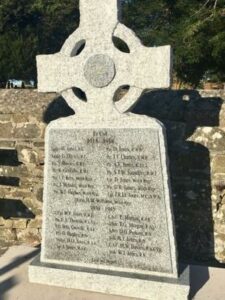
The Great War, 1914-1918
William George Anthony, Private, 4376, Pembroke Yeomanry. William was the son of John and Mary Anthony, of Penpont, Llanarthne. He enlisted at Carmarthen on 17 October 1914 into the Pembroke Yeomanry. William served in Egypt with the 1/1st Battalion, Pembroke Yeomanry from 4 March 1916 until being evacuated sick on 5 September 1916. He was hospitalised in Britain after returning home, and was found to be suffering from tuberculosis brought on by his service in Egypt. He was subsequently discharged from the army as medically unfit, and went to live with his parents, who had moved to Brynceitho, Cefneithin. He died on 4 November 1918 aged 24. William’s case was put forward to the CWGC by myself on 8 May 2013, and he was accepted for commemoration on 11 November 2014. He will be commemorated in the United Kingdom Book of Remembrance until his grave can be found. William is commemorated at Tabernacle Chapel, Cefneithin. His name is omitted from the new memorial.
Ivor Thomas Charles, Private, 39247, South Wales Borderers. Ivor was the son of David and Mary Ann Charles, Shoemaker, of Bank y Mansel, Llanarthne. He enlisted at Carmarthen into the Monmouthshire Regiment. Sometime later he was transferred into the 6th Battalion, South Wales Borderers, Pioneers to the 25th Division. The Division moved to France in September 1915 and moved to the Vimy sector. They fought in every major battle thereafter and took part in some of the terrible fighting during the German Spring offensive of 1918 before being moved to the Soissons Sector. On 27 May 1918 a German attack hit them again, and during the coming days the Division was virtually annihilated. By 9 June, a decision had been taken to break up what was left of the Division to reinforce other formations. The core of the Division returned to England to rebuild, and returned to the front in September 1918, moving at first to St Riquier near Abbeville. Late in the month, it entrained for Fourth Army, coming under XIII Corps which was by now engaged in the more or less continuous and eventually victorious advance across Picardy, fighting at the Battle of Beaurevoir. They then fought during the remainder of the great offensive, at the Battle of Cambrai, the Pursuit to the Selle, the Battle of the Selle, and the Battle of the Sambre. Ivor was taken ill and died during the final offensive, and he died on 29 October 1918, aged 30. He is buried at Pont-De-Nieppe Communal Cemetery, France.

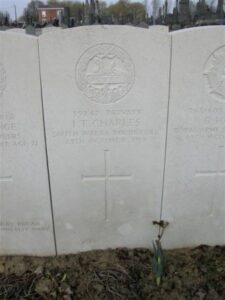
George Davies, Sapper, 448501, Royal Engineers. George was the son of Thomas and Ann Davies, of Carreglas, Cross Hands. He lived with his wife at Glynllwchwr Road, Pontardulais prior to enlisting at Ammanford into the Royal Engineers. George was posted to the 90th Field Company, Royal Engineers, which was attached to the 9th (Scottish) Division. The Division had been in France since fighting at Loos in September 1915. It fought on the Somme in 1916, then at Ypres and Cambrai in 1917. In March, 1918 they were still in the Cambrai area, and were one of the Divisions hit there by the German Spring Offensive, fighting at the Battle of St Quentin, and the First Battle of Bapaume. After suffering terrible casualties the Division were moved to Flanders to rebuild, but the Germans launched another offensive there during April 1918, and the Division then took part in the Battles of the Lys, at the Battle of Messines, the Battle of Bailleul, the First Battle of Kemmel, the Second Battle of Kemmel and then during the Advance in Flanders, where they took part in the Action of Outtersteene Ridge. George was wounded in Flanders, and was evacuated to the Base Hospital at Longuenesse. He died of wounds there on 1 August 1918, aged 21, and is buried at Longuenesse (St. Omer) Souvenir Cemetery, France.
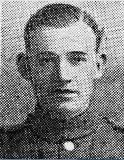
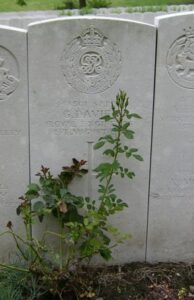
Thomas Davies, Lance Corporal, 68852, Royal Welsh Fusiliers. Thomas was the son of William and Mary Davies, of Caerllwyn, Foelgastell. He was employed at the New Cross Hands Collieries prior to the war, before enlisting at Carmarthen into the Pembroke Yeomanry. Thomas then transferred to the Welsh Regiment, and the Royal Irish Rifles, before being posted to the 11th Battalion, Royal Welsh Fusiliers, which was in Salonika, as part of 67 Brigade, 22nd Division. Thomas was killed in action in Salonika on 31 July 1917, aged 21. He is buried at Doiran Military Cemetery, Greece. (Soldiers Died in the Great War shows his date of death as 31 July 1917, as do the original grave registration forms, but the CWGC show his date of death as 31 July 1918 and have that date on his headstone. Local newspaper reports confirm he died in 1917.)
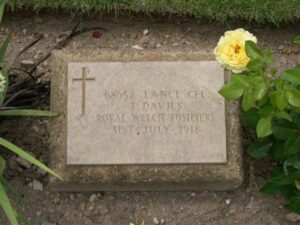
David Howell Griffiths, Sapper, 6405, Australian Engineers. David was born at Llanarthne, and was the brother of Ruth Roberts, Porthyrhyd, Llanarthne. He was a miner, and had served with the 4th Welsh prior to emigrating to Australia around 1910, after being advised to live in a better climate, due to ill health. He then lived with his sister, Mrs Ruth Roberts, at High Street, Grange, South Australia. David enlisted at Adelaide on 14 October 1915, into the Australian Engineers, and joined the 13th reinforcements to the 3rd Field Company, which was attached to the 1st Australian Division. David embarked on 20 March 1916 at Sydney aboard HMAT Armadale, and arrived at Alexandria on 24 April 1916. Within weeks he was admitted to Hospital at Abbassia, where he was discovered to be suffering from tuberculosis. On 24 June 1916 David embarked at Alexandria for Australia, after being discharged from the AIF as medically unfit. He died on 10 February 1920, aged 30, and is buried at Adelaide (West Terrace) Cemetery, Australia. David is not named on the new memorial.
Rhys Griffiths, Private, 57935, Royal Welsh Fusiliers. Rhys was the son of Owen and Sarah Griffiths, of Bron Gwendraeth, Cwm Mawr, Tumble. He enlisted at Llanelli into the Army, and after training was posted to the 9th Battalion, Royal Welsh Fusiliers, which was attached to 58 Brigade, 19th (Western) Division. The Division had been in France since July 1915, and had fought at the Battle of Loos that year, then on the Somme in 1916, and at Messines and Ypres in 1917. In 1918 they were caught up in the German Spring Offensive near St. Quentin, where they suffered terrible casualties, and fought at the Battle of Bapaume. They moved to Ypres, but were caught up in the German attack at Messines, and at Bailleul, and Kemmel. After suffering terribly again, they moved South to the quieter French sector to rebuild, but were caught up in the German offensive on the Aisne. Rhys was taken prisoner by the Germans at some stage, and was taken to a Prisoner of War Camp in Germany. He died as a POW on 24 July 1918, aged 18, and is buried at Niederzwehren Cemetery, Germany.
William John Hughes, Private, 26467, Welsh Regiment. William was the son of John and Emily Hughes, Gorsfach, Gorslas. He worked as a coalminer at Tylorstown prior to the war and enlisted at Porth on 23 April 1915 into the 17th Battalion, Welsh Regiment. The Battalion was attached to 119 Brigade, 40th (Bantam) Division, which was formed between September and December 1915, composed of bantam units and others which had a mixture of regulation-height and shorter men. Weeding out of very under-sized or unfit men delayed the training programme, and it was not until late spring 1916 that the Division was ready to proceed on active service. The Division moved to France between 1 and 9 June, and moved to the front near Loos. Late in 1916 they moved south to the Somme, and fought at the Battle of the Ancre, and remained in the area over the winter. In March, 1917 the Germans withdrew to their shortened line, called the Hindenburg Line, and the 40th Division were one of the Divisions that followed the withdrawal. William was killed in action during this period, on 24 April 1917, aged 23. He is buried at Fifteen Ravine British Cemetery, Villers-Plouich, France.
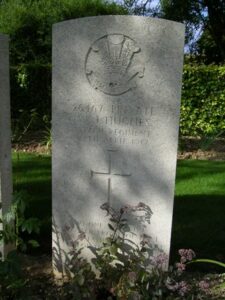
David Robert James, Private, 1490, Welsh Regiment. David was born at Voelgastell, and had enlisted at Llanelli into the 2nd Battalion, Welsh Regiment. The battalion had moved to France at the outbreak of war attached to 3 Brigade, 1st Division, and had taken part in the Battle of Mons, and the subsequent retreat to the Marne in the first weeks of the war. After successfully stopping the German drive on Paris, the 3rd Division moved to Ypres, where it was tasked with the defence of the ancient City, to prevent the German drive to the Channel Ports. David arrived in France on 27 January 1915, as part of a large batch of reinforcements for the 2nd Welsh, which had been decimated during the defence of Ypres. He fought with the battalion during the following Battles of Festubert and Neuve-Chapelle, but was killed in action during the Battle of Loos on 26 September 1915. David has no known grave, and is commemorated on the Loos Memorial, France.
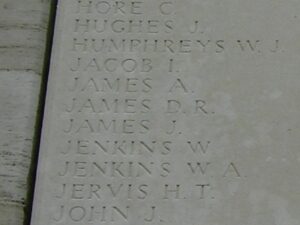
John Jenkins, Private, 60402, Labour Corps. John was the Son of David and Anne Jenkins, of Llwynhelyg, Llanarthne. He had enlisted at Marylebone into the 34th Battalion, Royal Fusiliers, which was formed at Falmer in May 1916, moving to France sometime after June 1916. The battalion had been formed as a Labour Battalion, and in April 1917 became a Labour Corps Battalion. John was wounded during the German Offensive in 1918. He died of his wounds on 13 May 1918, aged 45, and is buried at St. Sever Cemetery Extension, Rouen, France. John is not named on the new memorial.
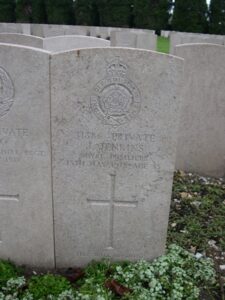
Arthur Edward Jones, Private, 10921, Kings Shropshire Light Infantry. Arthur was born at Llanarthne in 1890, the son of George and Jane Jones. George was the Gardener at Middleton Hall, and the family lived at Garden Cottage. By 1901 the family had moved to Newbridge-on-Wye, Radnorshire, and Arthur enlisted at Hereford into the 5th Battalion, King’s Shropshire Light Infantry, which was attached to 42 Brigade, 14th (Light) Division. The Division was to see its first action during the Action of Hooge, where the Division were the first to be attacked by the German use of flamethrowers. They then fought at the Second attack on Bellewaarde. In July, 1916 they moved to the Somme, and fought at the Battle of Delville Wood, and then the Battle of Flers-Courcelette, and in March 1917 followed the German Retreat to the Hindenburg Line. May saw them at Arras, where they took part in the First Battle of the Scarpe, which is where Arthur was killed on 3 May 1917, aged 27. He is commemorated on the Arras Memorial, France. Arthur is also commemorated at Gorslas.
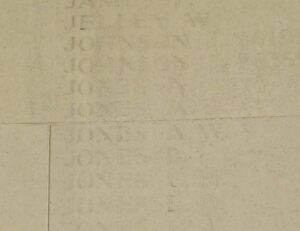
David Jones, Lance Corporal, 8436, Welsh Regiment. David was born in 1886, the son of Henry and Mary Jones, of Penrhiwgoch, Maesybont. He was a widower when he married Susannah Williams, of Llanarthne. He was a pre-war regular, and had enlisted at Carmarthen into the 2nd Battalion, Welsh Regiment. At the outbreak of war, the 2nd Welsh moved immediately to France attached to 3 Brigade, 1st Division. The Division had been one of the first to arrive in France, fighting at the Battle of Mons, and taking part in the retreat to the Marne, where the Germans were stopped. They then fought at the Aisne, and at Chivy, before being moved north to Ypres. Here they fought at the First Battle of Ypres, where they again stopped the German Offensive, before wintering in Flanders. David was killed while the 2nd Welsh were at Cuinchy on 20 April 1915. He is buried at Guards Cemetery, Windy Corner, Cuinchy, France.
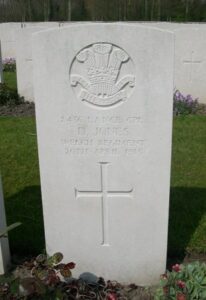
David Jones, Private, 13131, Royal Welsh Fusiliers. David was the son of William and Hannah Jones, of Dock Terrace, Llanarthne. He enlisted at Tumble into the 8th Battalion, Royal Welsh Fusiliers, which was attached to 40 Brigade, 13th (Western) Division. On 13 June 1915 the first ships carrying the Division left port, and moved to Alexandria. By 4 July, all units had moved to Mudros, preparatory for landing on Gallipoli, and between 6 and 16 July 1915 13th Division landed on Cape Helles and relieved the 29th Division. They left and returned to Mudros at the end of the month, and the entire Division landed at ANZAC Cove between 3 and 5 August, 1915, taking part in the Battles of Sari Bair, Russell’s Top, and Hill 60, ANZAC. David was wounded at Sari Bair, and taken aboard a Hospital Ship where he died of wounds on 17 August 1915, being later buried at sea. He was 19 years old, and is commemorated on the Helles Memorial, Gallipoli.
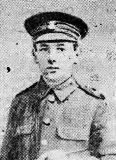
Edward Jones, Sergeant, 200808, Welsh Regiment. Edward resided at Dryslwyn Station, Llangathen, the son of David Jones, Stationmaster. He enlisted on 15 October 1912 into the 4th Battalion, Welsh Regiment, which was the local Territorial unit. He didn’t serve overseas, as he was deemed to be unfit, and was discharged on 23 October 1917 as being no longer physically fit for war service. Edward died of Tuberculosis at Station House, Dryslwyn on 14 January 1918, aged 28. He was accepted for commemoration by the CWGC on Saturday 14 January 2012, following my research and was to be commemorated on the Brookwood (United Kingdom 1914-1918) Memorial. After a lot of work I finally managed to find that Edward was buried in Llanarthney Churchyard, and the details were forwarded to the CWGC who have recently installed this headstone to commemorate him. Edward is not named on the new war memorial.
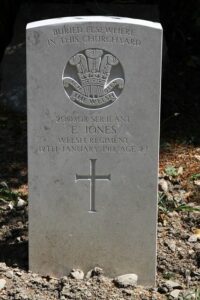
Herbert James Jones, Sapper, 96505, Royal Engineers. Herbert was born in 1884, the son of John Jones and Harriet Jones (nee Davies), of Llanarthney. The family then moved to 37, High Street, Abergwili several years prior to the war, and Herbert married Edith Florence Stork there in 1909. The couple then moved to Eiros Cottage near Llandebie, where Herbert worked as a miner, then moved again to Edith’s native London and settled at Murray Arms, 81, Paul’s Road, Camden Town, London. Herbert enlisted in London into the Royal Engineers and due to his mining experience, was posted to the 171st Tunnelling Company, Royal Engineers. The Company had been formed between February and March 1915 from a small number of specially enlisted miners, with troops selected from the Monmouthshire Siege Company of Royal Engineers and as a result comprised of a large number of miners from South Wales. The Company then moved to the Ypres Salient, under the command of the Second Army and was first employed in March 1915 in the Hill 70 and the Bluff area near Ypres, where it began one of the most terrifying campaigns of the Great War, the war underground. The tunnellers dug a network of dugouts, subways and mines around the Ypres Salient, and the men manning the trenches above grew to fear the sound of digging beneath their feet, after the explosion of several mines in the sector. On 2 June 1915, Herbert was at work underground in the Hill 60 Sector, when the Germans blew a camouflet, a small mine designed to collapse galleries. One man of Herbert’s Company became trapped, so Herbert and some other Sappers attempted a rescue. Herbert died underground that day as a result of lack of oxygen. The 31-year-old has no known grave and is commemorated on the Menin Gate Memorial at Ypres. Herbert is one of the new additions to the memorial at Gorslas.
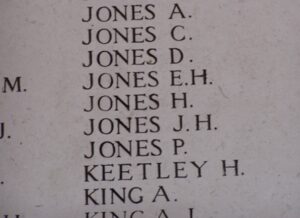
John Rupert Llewellyn Jones, MC, Captain, South Wales Borderers. John was born in Llanelli in 1896, the son of William Henry Jones and Anne Jones (nee Llewellyn). By 1911 the family was living at Llwynhelig, Llanarthney and John was away in a boarding school in Canterbury. He was commissioned into the South Wales Borderers and posted to France with the 5th Battalion, South Wales Borderers, which was attached to the 19th Division. John was a gallant officer who was mentioned in despatches and then awarded the Military Cross for his gallantry during the German Spring Offensive at Wytschaete in April 1918. The citation for his award read: ‘For conspicuous gallantry and devotion to duty in commanding a platoon, and on many occasions a company. He held on to positions until the last possible moment, thereby inflicting heavy losses on the enemy and greatly delaying his advance. He rallied men of other units when they had lost their leaders.’ John survived the war and returned home to west Wales before becoming a successful businessman and plantation owner in Malaysia. He died in Penang General Hospital on 17 November 1938, aged 42. John is obviously not a casualty of war, so his inclusion on the new memorial is interesting to say the least.
Thomas Stephen Ray, Private, 47582, Welsh Regiment. Thomas was born at Llanarthne in 1892, the son of John Steven and Annie Maria Ray. The family had lived at Bridgend for several years prior to Annie’s death, before returning to live at Bwlchgarw, Cefneithin. Thomas worked as a labourer prior to enlisting into the 2nd Battalion, Welsh Regiment at the outbreak of war. He served with the battalion in France from 13 September 1914, and would have taken part in the terrible fighting at the First and Second Battles of Ypres. He married Sarah Catherine Williams, of Nantyfyllon, while on leave in 1915 and rejoined the battalion in France. He was posted as a deserter on 26 August 1916 while the battalion was on the Somme, but must have been just missing, as he was then posted to the Training Reserve before continuing to serve with the 2nd Welsh for the remainder of the war. He died, probably of influenza, while still in France on 10 February 1919, aged 27, and is buried in Les Baraques Military Cemetery, Sangatte, France. Thomas is not named on the new memorial.
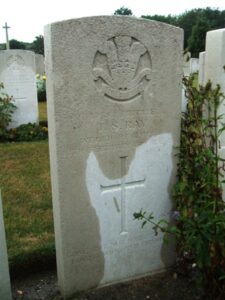
Idris Tudor Rees, Private, 75290, Welsh Regiment. Idris was the son of Daniel George and Mary Ellen Rees, of Min-yr-Afon, Cross Hands. He enlisted at Cardiff on 23 May 1918 into the army, and on 14 September 1918 was posted to France, joining the 15th Battalion, Welsh Regiment, which was attached to 114 Brigade, 38th (Welsh) Division. The Division had been in France since December 1915 and had fought at Mametz Wood and Pilckem Ridge. Idris joined the battalion during the course of the advance to victory, after it had advanced across the Somme battlefields towards the Hindenburg Line. The Division then fought at the Battle of Beaurevoir, and moved up towards Cambrai, capturing Villers-Outreaux. Idris was wounded during this great advance, and died of wounds on 9 October 1918, aged 19. He is buried at Beaulencourt British Cemetery, Ligny-Thilloy, France.
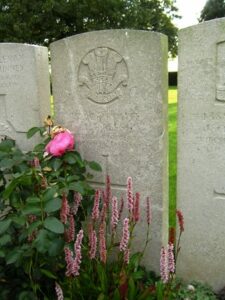
Stanley Thomas William Saunders, Private, 34121, Royal Welsh Fusiliers. Stanley was the son of Thomas and Rhoda Saunders of Ipswich. He had moved to Llanarthne prior to the war, where he worked as a cowman. He enlisted at Tumble on 8 September 1914 into the Welsh Regiment, and married Miriam Davies, of Tanylan, Maesybont, Gorslas on 30 December 1914. On 11 August 1915 he was transferred to the 1st Garrison Battalion, Royal Welsh Fusiliers, and sailed for Gibraltar, where the battalion was on garrison duties. On 8 May 1916 Stanley was posted to France, joining the 10th Battalion, Royal Welsh Fusiliers, which was attached to 76 Brigade, and by the summer of 1916 was part of the 3rd Division. Stanley was killed on the Somme, during the fighting around Bazentin, on 20 July 1916. He was 29 years old, and is commemorated on the Thiepval Memorial, France. The photograph, which is reportedly of Stanley, is courtesy of Graham Davies.
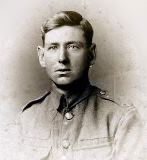
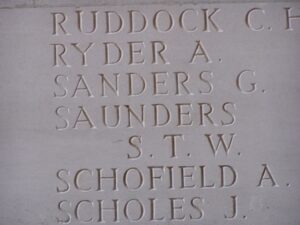
Joseph Henry Webster, Private, 27548, Kings Shropshire Light Infantry. Joseph was the son of Joseph Henry and Christina Webster, of Liverpool. By 1911 Joseph was working as a ploughman for John and Letitia Tobias, at Llanarthne. He married Rachel Evans, of Curn Dancerrig, Bronwydd Arms in 1916, and enlisted at Carmarthen into the Welsh Regiment. Joseph was then posted to the 6th Battalion, King’s Shropshire Light Infantry, which was attached to 60 Brigade, 20th (Light) Division. The Division had seen its first action in September 1915 at Fromelles. It then saw further fighting on the Somme in 1916, and at Ypres in 1917, before taking part in the Battle of Cambrai at the end of the year. They remained in the area between Cambrai and St. Quentin over the winter of 1917/18 and were attacked there by the German Spring Offensive of 21 March, 1918. They then fought in the retreat at the Battle of the Somme Crossings and the Battle of Rosieres. The Division was withdrawn after the heavy fighting of the Somme battles, moving on 20 April 1918 to an area south west of Amiens. Joseph was wounded here while the battalion was rebuilding, and was evacuated to the Base Hospital at Wimille. He died of wounds there on 10 September 1918, aged 27, and is buried at Terlincthun British Cemetery, Wimille, France.
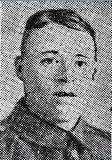
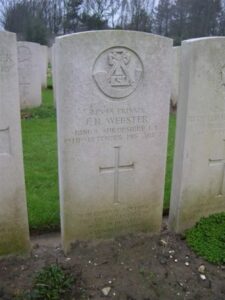
Howell Morgan Williams, Second Lieutenant, Welsh Regiment. Howell was the son of John and Catherine Williams, of Gwynondale, Llanarthne, and was commissioned into the Welsh Regiment, serving with the 19th Battalion, which was the Pioneer Battalion to the 38th (Welsh) Division. The Division had landed in France during December 1915 and had spent their first winter in the trenches near Armentieres. In June they marched south to the Somme, where they were tasked with the capture of Mametz Wood. The attack on the wood began on 7 July, but met with fierce resistance, and it took until 14 July to clear the wood. The Division suffered terrible casualties at Mametz, and were taken out of the line, and moved to Ypres to rebuild. Howell was killed in action during the build up to the Third Battle of Ypres, on 24 June 1917, when a shell crashed into his dugout, killing him and Captain Arthur Ernest Evans, of Swansea, and wounding Lieutenant Bert Palmer and another man. Howell was 23 years old, and is buried at Bard Cottage Cemetery, Belgium. He is also commemorated on the Llanegwad Memorial. (The County Roll and the Gorslas Memorial commemorate his brother, Chaplain Philip Williams, but he lived for many years after the war).
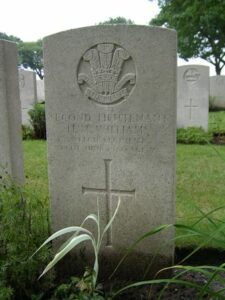
———————————————————————————————————————————————————
World War Two, 1939-1945
Maldwyn Wallace Davies, Leading Aircraftman, 3010798, Royal Air Force Volunteer Reserve. Maldwyn was the son of David Morgan Davies and May Davies, of Drefach, and served with 511 Squadron, RAF. By the end of the war, the Squadron was based at Malta, equipped with the Avro Lancastrian C2. Maldwyn was among twenty-one men lost during the crash of Avro York Serial MW125, which crashed into the sea about 100 miles west of Penange on 6 October 1946. He was twenty-two years old, and is commemorated on the Runnymede Memorial, Surrey.
Leslie Charles Fortey, Sapper, 2004187, Royal Engineers. Very little is known of Leslie, except that he was the son of Thomas and Emma Fortey, of Wern Fach, Llanarthne. He died on 16 December 1945 aged 28, and is buried at Llanarthne (St. David) Churchyard. Leslie is not named on the new memorial even though he is buried in the Churchyard.
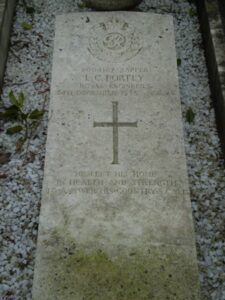
Donald Glyndwr Greville, Flying Officer (Pilot), 143449, Royal Air Force Volunteer Reserve. Donald was the son of William and Lily Greville, of Drefach. He enlisted into the Royal Air Force Volunteer Reserve and was trained as a pilot. Donald was attached to No. 63 Operational Training Unit, which was based at RAF Chedworth, and was training on the Bristol Beaufighter II. On 1 January 1944 he took off from Chedworth flying Beaufighter R2304 to carry out a training flight and had completed its operations and began returning to base when an engine exploded and caught fire. Losing height, Donald and his observer baled out of the stricken aircraft, but Donald’s parachute failed to open and he was killed. The remains of the 22-year-old were brought back to west Wales and he was buried in Drefach (Capel Seion) Congregational Chapelyard.
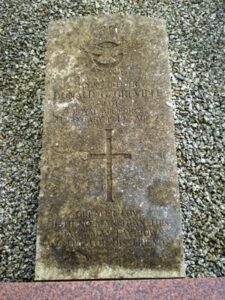
Daniel Hughes, Petty Officer Cook (O), D/L 14323, Royal Navy. Daniel was born on 27 December 1900, the son of John and Sarah Hughes. He served in the Royal Navy, as a Cook aboard the Dido Class light cruiser HMS Hermione. Hermione served in the Mediterranean and was torpedoed by the German submarine U205 on 16 June 1942, sinking with the loss of 87 men, including Daniel. He was 41 years old, and is commemorated on the Plymouth Naval Memorial, Devon.
Iestyn James, Sergeant, 1381676, Royal Air Force Volunteer Reserve. Iestyn was the son of David and Harriet Ann James, of Cefneithin, and served with 150 Squadron, RAF, which flew the Vickers Wellington III, based at RAF Snaith. The Squadron took part in the strategic night bombing offensive, and flew hundreds of sorties over occupied Europe. Iestyn was killed when his Wellington III, Serial X3309, was shot down during a raid on Bremen on 27 June 1942. He was 20 years old, and is commemorated on the Runnymede Memorial, Surrey.
Samuel Leslie Jenkins, Captain, 88225, South Wales Borderers. Samuel was born in 1915, the son of John Jenkins and Ellen Jenkins (nee Bowen), of 4, Mansel Street, Carmarthen. He lived with his wife Jean Rosaleen Jenkins at Llanarthney prior to the war. Samuel had enlisted into the South Wales Borderers, but soon rose to the rank of Captain, before applying for Commando training, and after completing his Command course at Achnacarry was posted to No. 2 Commando. Samuel was wounded during operations on Sicily on 16 August 1943 but returned to duty as soon as he had recovered. On 4 March 1944 Samuel and another officer of 2 Commando were on reconnaissance in preparation for a raid on Solta, when Samuel was wounded and captured. He died of his wounds as a POW on 6 March 1944. The 29-year-old is buried in Belgrade War Cemetery, Serbia & Montenegro. Samuel is not named on the new memorial, although there is a memorial processional cross inside the Church which is dedicated to him.
Haydn John Jones, Stoker 1st Class, P/KX 95866, Royal Navy. Haydn was born on 16 May 1915, the son of Evan and Beatrice Rebecca Jones. He served in the Royal Navy aboard the mighty Battleship HMS Hood. Hood was part of a strong naval force involved in the hunt for the German German pocket battleship Bismarck in the North Atlantic when they came into contact with Bismarck on 24 May 1941 and began firing their massive naval guns. A shell from the Bismarck penetrated the deck of Hood which exploded and sank with the loss of all but two of her crew. Haydn was 26 years old when he was killed that day, and is commemorated on the Portsmouth Naval Memorial, Hampshire.
Herbert Llewelyn Jones, Sergeant (Flight Engineer), 570542, Royal Air Force. Herbert was born on 2 January 1921, the son of David John Jones and Esther Elizabeth Jones (nee Walters), of 51, High Street, Abergwili. His mother Elizabeth died in 1923, and Herbert went to live with his grandparents, John and Harriet Jones and at Brynderwen, Llanarthney. After leaving his local school at Llanarthney, Herbert gained a place in Carmarthen Grammar School. He enlisted into the Royal Air Force upon leaving school and after completing his training as a Flight Engineer was posted to 9 Squadron, Royal Air Force, which was a medium bomber Squadron, originally equipped with the Vickers Wellington. The squadron utilised their Wellington’s on anti-shipping sorties in the early stages of the war, before converting to Avro Lancaster’s in September 1942 and joined RAF Bomber Command, based at RAF Waddington. On the night of 4 April 1943 Herbert took off from Waddington aboard Avro Lancaster, Serial ED696 which was part of a force bound for Kiel. The Lancaster was intercepted by a German night-fighter on the following morning, 5 April 1943, and crashed in flames near Grossenaspe, killing all seven of her crew. Herbert, who was just 22 years old, was buried alongside his fellow crewmen in Neumunster Civil Cemetery, but their graves were later exhumed and they were re-interred in Hamburg Cemetery, Germany in September 1946. His uncle, Herbert James Jones, fell during The Great War.
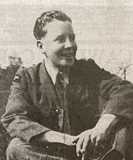
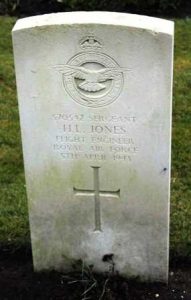
Tom Howell Jones, Driver, T/10696291, Royal Army Service Corps. Tom was the elder son of Thomas and Elizabeth Jones, of Tycroes. Very little is known of his service, but he served as a Driver with the Royal Army Service Corps. He was 28 years old when he died as a result of active service on 21 August 1945, and is buried at Llanlluan Methodist Chapelyard. His younger brother William Elvet Jones had been killed in Germany just six months earlier. For some reason Tom’s name has been omitted from the new memorial, even though his brother William is named on it.
William Elvet Jones, Lance Corporal, 4196920, Royal Welch Fusiliers. William was the son of Thomas and Elizabeth Jones, of Gorslas, and served with the 7th Battalion, Royal Welsh Fusiliers. The battalion served with 158 Brigade, 53rd (Welsh) Division, which landed in Normandy in June 1944. After taking part in the break out from Normandy, the Division took part in the drive north through France and Belgium into Holland. At the beginning of 1945 the Division marched into Germany, and William was killed during the fighting in the Reichswald Forest on 11 February 1945. He was 26 years old, and is buried at Reichswald Forest War Cemetery, Germany. His elder brother Tom Howell Jones died six months later, as a result of his war service.
William Islwyn Jones, Leading Stoker, D/KX 96144, Royal Navy. William was the son of George and Alice Jones, of Drefach, and served in the Royal Navy aboard HMS Itchen. Itchen was a River class frigate launched in 1942. She blew up on 23 September 1943 when hit by acoustic homing torpedo fired by the German submarine U-66, with all but three of her crew surviving. William was one of the dead. He was 23 years old, and is commemorated on the Plymouth Naval Memorial, Devon.
Elwyn Morgan, Leading Aircraftman (Navigator), 964106, Royal Air Force Volunteer Reserve. Elwyn was the son of Thomas and Jane Morgan, of Drefach, and the husband of Lilian Myfanwy Morgan, of Drefach. He served as a Navigator with 1 Squadron, RAF, which was a fighter squadron, equipped with the Supermarine Spitfire IXB, based at RAF Detling. Elwyn died on active service on 17 November 1944, aged 29, and is buried at Drefach (Capel Seion) Congregational Chapelyard, Wales.
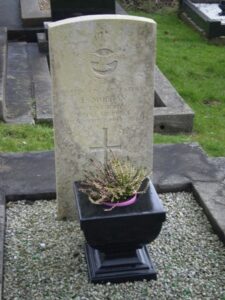
Thomas Glyndwr Morgan, Lance Bombardier, 993995, Royal Artillery. Thomas was the son of David and Mary Ann Morgan of Gorslas, and the husband of Meirion Morgan, of Llanelly. He served with the Royal Artillery, attached to 1 Airlanding Light Regiment, which was a specialist glider borne unit, equipped with light artillery pieces, especially formed to support airborne forces. Thomas took part in the famous Operation Market Garden, which was designed to seize the bridges over the River Rhine, and he landed in Arnhem at the opening of the operation. He was killed in action at Arnhem on 18 September 1944, aged 30, and is buried at Arnhem Oosterbeek War Cemetery, Netherlands.
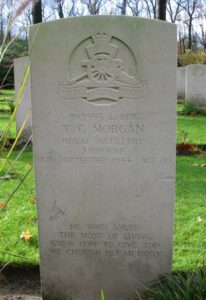
David Owen Perkins, Petty Officer Stoker, D/KX 81082, Royal Navy. David was born on 18 August 1909, the son of Richard and Sarah Perkins, of Maesybont, Carmarthenshire. He served in the Royal Navy aboard HMS Neptune. Neptune was a Leander class light cruiser, and was part of Force K, which was sent out on 18 December 1941, to intercept a convoy bound for Tripoli. On the night of 19 December 1941, Neptune, leading the line, struck two mines, and sank. David was one of the 740 men lost aboard her that night. He was 32 years old, and is commemorated on the Plymouth Naval Memorial, Devon.
Ronald Henry Pitt, Gunner, 800084, Royal Artillery. Ronald was born at Bryngwyn, Llanarthne on 23 January 1912, the son of Edward Robert and Ellen Eliza Pitt. The family had moved back to his fathers native Herefordshire prior to the war. Ronald married Irene Grace Morris in 1937 and enlisted into the Royal Artillery following the outbreak of war. He was posted to the Far East with the 137th Field Regiment, Royal Artillery, which was part of the Singapore Garrison. He was taken prisoner by the Japanese following the surrender of Singapore on 15 February 1942 and was sent to Thailand with ‘F’ Force in April 1943. Ronald died at Kanchanaburi ‘F’ & ‘H’ Force hospital of beri-beri and tropical ulcers on 13 December 1943, aged 38. He was originally buried in Kanchanaburi ‘F’ & ‘H’ Force Burial Ground No. 3, but after the war the graves were re-located and he now rests in Kanchanaburi War Cemetery, Thailand. Ronald is not named on the new memorial.
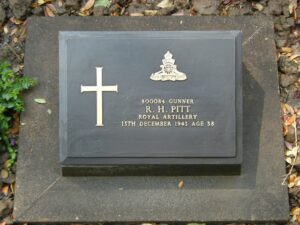
Horace Arthur Ransom, Lieutenant, 269389, East Surrey Regiment. Horace was born at Llanarthne on 2 February 1914, the son of Arthur Ransom and Mary Ann Ransom (nee Samuel). By 1937 he was living at 135, Shaftesbury Parade, Richmond, Surrey, where he married Ivy Reader. Horace was commissioned into the East Surrey Regiment on 2 April 1943 and was later attached to the Green Howards (Yorkshire Regiment). Horace took part in the campaign in North Africa, before his battalion embarked for Italy, to aid in the campaign to drive the Germans out of the country. Horace went out on a patrol at Le Piane, near Arielli during the morning of 28 December 1943, but came into contact with a German machine-gun post and was wounded. Unable to escape, he was taken prisoner by the Germans, but died shortly afterwards of his wounds. The 30-year-old is buried in Milan War Cemetery, Italy. All official sources state his date of death to have been 27 December 1943, but the war diary for his unit states the 28th. Horace is not named on the new memorial.
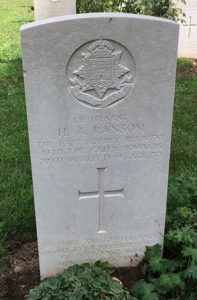
Ellis Adriel Thomas, Driver, T/14552607, Royal Army Service Corps. Ellis was the son of John and Elizabeth Thomas of Gorslas, and the husband of Irene Thomas, of Hanley, Stoke-on-Trent. He served with the Royal Army Service Corps as a Driver, and was killed during the drive through Holland on 19 September 1944. Ellis was 25 years old, and is buried at Eindhoven (Woensel) General Cemetery, Netherlands.